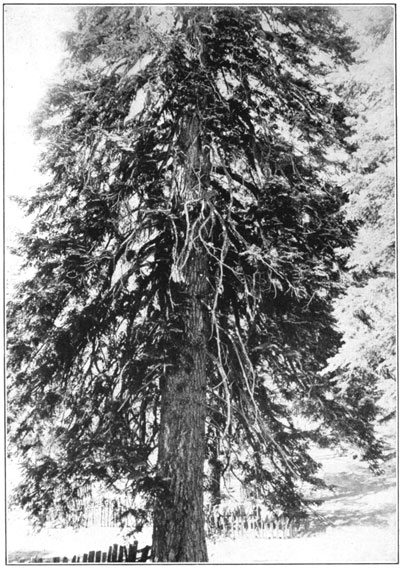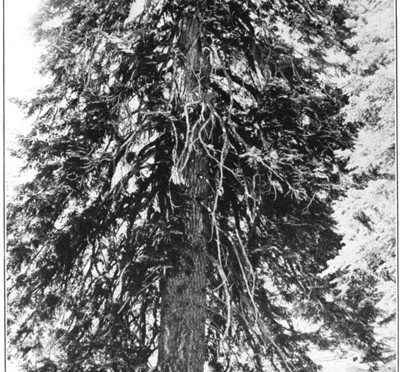Forests of Crater Lake National Park
White Fir (Abies Concolor)
Conspicuous in the higher forests of southern Oregon are a number of true firs belonging to the genus Abies, which includes also the well-known balsam fir of the East. Douglas fir should not be confused with the true firs, as it is a widely different tree to which the name fir has become attached by popular usage. All of the true firs are fine handsome trees, many of them large in size and producing excellent timber, others smaller and limby and found only at higher altitudes. Eight species occur naturally in the Pacific coast forests, and of these at least four occur in or near the Crater Lake National Park.
Towering among the Douglas fir and pines south of the park, is an abundant tree, the true white fir (Abies concolor), whose massive gray trunks are unlike those of any other found in the forest. White fir (fig. 10) reaches a height of 200 feet under favorable conditions, and occasionally the trunks are 5 feet and more through. It seldom reaches this size except in the California Sierras. In southern Oregon half this diameter and 120 feet in height is nearer the average dimension for white fir. This tree may be recognized by its gray-furrowed bark, and by its dense conical crown, both when young and in old age.

Fig. 10—White fir (Abies concolor) 9 feet 3 inches in diameter; 115 feet high.
White-fir needles are usually between 1 and 2 inches long, and on the lower branches they spread out from the sides of the slender twigs forming beautiful flat sprays. The cones of white fir occur in dense clusters, and as in all of the true firs, stand upright on the very top of the tree or at the tips of the upper branches. Except for those that are cut off by the squirrels, or are detached when immature by wind or other causes, they are never found on the ground, as the cone scales fall away separately, leaving the central spike standing on the twigs. White fir matures its seed in one season, and in September the cones break up, sending their showers of seed and scales to the ground.
The botanical range of this tree is from southern Oregon to Lower California and east to the Rocky Mountains of Colorado, New Mexico, and Arizona. Nowhere is it valued to any extent for lumber as its wood is soft and sappy and the trees are greatly damaged by heart rot.
White fir does not grow at high altitudes, going up to only about 6,000 feet in the Crater Lake National Park region. It is found mainly along the southern side, following fairly closely the range of sugar pine.
Other pages in this section
*** previous title *** --- *** next title ***


